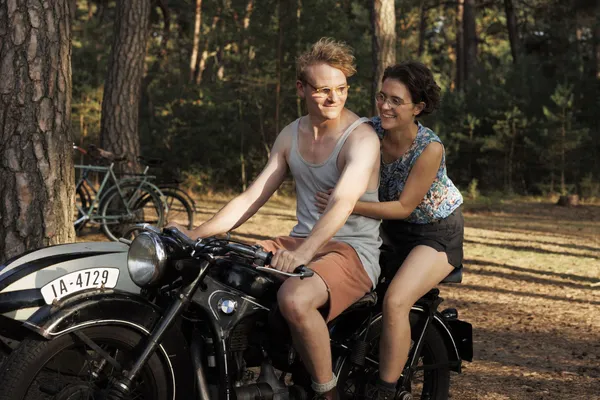 |
| From Hilde With Love |
German director Andreas Dresen and screenwriter Laila Stieler's biographical drama, From Hilde, With Love, is set in 1942 Berlin, where Hilde Coppi (Liv Lisa Fries), a young woman, has fallen in love with Hans (Johannes Hegemann). Pregnant, she's naïve of the danger she has placed herself and her unborn child in by becoming involved in the anti-Nazi resistance. Arrested by the Gestapo, she's forced to give birth to her son in prison, and less than a year after his birth, becomes a victim of the regime's violence.
Dresen's previous credits include Nachtgestalten, which revolves around the Pope's visit to Berlin and an assortment of characters experiencing an unpleasant night in the city. He also directed As We Were Dreaming (Als Wir Träumten), set in East Germany in the Nineties, which follows three boys who act on their love for techno music. Meanwhile, Dresen and Stieler previously collaborated on Stilles Land, about a young theatre director who arrives in a small town and attempts to stage a performance of Beckett's Waiting For Godot.
In conversation with Eye For Film, Dresen discussed working around the film's intolerable darker moments and compelling his audience to confront difficult and uncertain questions. He also reflected on Liv Lisa Fries' emotionally stirring performance and creating a closeness between history and the present-day.
The following has been edited for clarity.
Paul Risker: Why filmmaking as a means of creative expression? Was there an inspirational or defining moment for you personally?
Andreas Dresen: Cinema is a powerful means for communicating with other people, and so, I do not want to produce a movie just for myself — I need to communicate with the audience.
I started out as an amateur filmmaker in East Germany with a small Super 8 camera. We'd show our little Super 8 movies on camping sites to people who were free in the evenings and wanted to watch them. We also had very interesting discussions, and I had this feeling that the film is finished in the communication process with the audience — that’s the journey.
I also feel that you have a political influence over people, and it's possible to give some people a little push in a certain direction that could be interesting for society. So, cinema is very emotional, and it offers an opportunity to create a conversation within society. And because German society is drifting more towards the right wing, where up-and-coming right wing parties are becoming stronger, then communication is more important than ever. That was also one of the reasons why we wanted to make this film.
PR: Current political developments emphasise the importance of learning lessons from history. However, there appears to be a reluctance to embrace the past. Instead, we appear compelled to repeat past mistakes.
AD: If you think about what happened in the past, you can learn a lot about the present, and that was also one of the reasons why we did not want to create a kind of Nazi Museum in our film. In From Hilde, With Love for example, we choose costumes and set designs that look a little more like they are from the present, even if it's more than 80 years ago. And especially for younger people, we wanted to give them the impression that things like this can happen anywhere and to them, even if they feel safe right now, because things can change very fast. So, if you watch the film, you will recognise that we avoided these typical Nazi clichés of the swastikas and other things like that, to bring this story closer to present-day for the audience.
PR: Was the film always intended to have a non-chronological structure, and how does it shape the film's emotional register?
AD: The first draft of Laila Stieler’s screenplay was told chronologically. It started when Hilde and Hans were getting to know each other and first fell in love, followed by their time in the resistance, and it was in the middle of the screenplay that Hilde was imprisoned. I really liked the screenplay, but I had the feeling that it was split into two totally different parts. One part was freedom and love, and the second part was prison and execution. And I had the feeling that this second part was hard to tolerate.
I spoke to Laila and told her I really liked the scenes but not the structure. In the middle of our conversation, I proposed we start in the middle when Hilde gets arrested, so we are telling the part of the story when she's in prison and then going backward to show the love story. And in so doing, we wouldn't end with the horrible execution but their first dance together.
Laila liked this idea, and she called me and said, “I tried it, and I think it could work. Let's do it like that.” And so, from that moment on, it had this structure, which is a mix of the different layers of the story. We also felt this could be helpful for the audience because it's easier to tolerate the more difficult moments of the story — the darkness of the prisons if you have the bright sky, the lake, and the summer mixed in, and the love story of Hilde and Hans when they maybe weren't aware of the danger they were in.
And in the final moment, when Hilde is executed, she’s looking into the sun. So, maybe the whole film is a flashback, because they say in the moments before you die, you remember the most important moments of your life. Everyone who watches this film can choose whatever he or she wants to think, but for us, it was helpful to mix it up.
PR: Hilde is a multilayered character who comes across as both confident and insecure, and in the early scenes you play with guilt and innocence, even naïveté and role-play or deceit. There are moments when you fear for her, but then at other moments, you admire her courage.
AD: We had some of the historical documents about the real Hilde — her letters, of course, and the descriptions of other people who knew her. But it was very important for our actress, Liv Lisa Fries, to frame all of these complex parts of the character.
When I asked Liv to play the part, she was a little surprised. She told me “Listen, I'm so different from this character,” and I told her, “You are an actress, and you can step into these shoes.” So, she figured out how she could play the character, and I immediately fell in love with her approach. At the end of the second day of shooting, she came to me and said, “I think I can handle this.”
Liv is a very special actress and, for me, often it was like she was not acting. It was like she let herself fall backwards with her eyes closed and was floating in the middle of the scene without thinking about what she was doing. It was often touching for me and the other crew members to see, and so, there were a lot of tears, not only because of the character, but Liv’s performance.
PR: From Hilde, With Love appears to create space for the audience to enter the film and respond to the story and its characters, rather than being guided by the filmmakers.
AD: The cliché of resistance fighters is that they are always very courageous, and they never misbehave. I grew up in East Germany where resistance fighters were traditionally seen as superheroes that were always bigger than life. I was not able to compare myself with them and so, I felt small and full of fear — I felt I couldn't do what they did.
Then there were those people that worked for the system, and when we look back on the Nazi regime, it's of course easy to blame them for everything that happened. But we didn't want to show these types of resistance fighters or those types of people that worked for the regime. Instead, in this film, they are sometimes a little friendly. For example, the judge. He's not the typical Nazi judge; a [Roland] Freisler. He’s not shouting or full of anger. And the guard Anneliese Kühn is also something in between.
We wanted to create a kind of ensemble, where you can choose who you want to identify with as a viewer. And it would be nice if you asked yourself what part you would have played if you lived in those times? And it's sometimes not so easy to answer, because even if you are working for the regime, maybe you do not always agree. But you have a family, and you’re full of fear, and you cannot work for the resistance because you think you're just a small man.
I think times like this, or regimes like this, are carried on the shoulders of the huge crowd of opportunists, and this is the problem. Of course, it's easy to say I would have been a resistance fighter, but we wanted you to look at this ensemble of different people with different decisions to make, and then decide what you would do.
From Hilde, With Love is released theatrically in the UK from June 27.





















